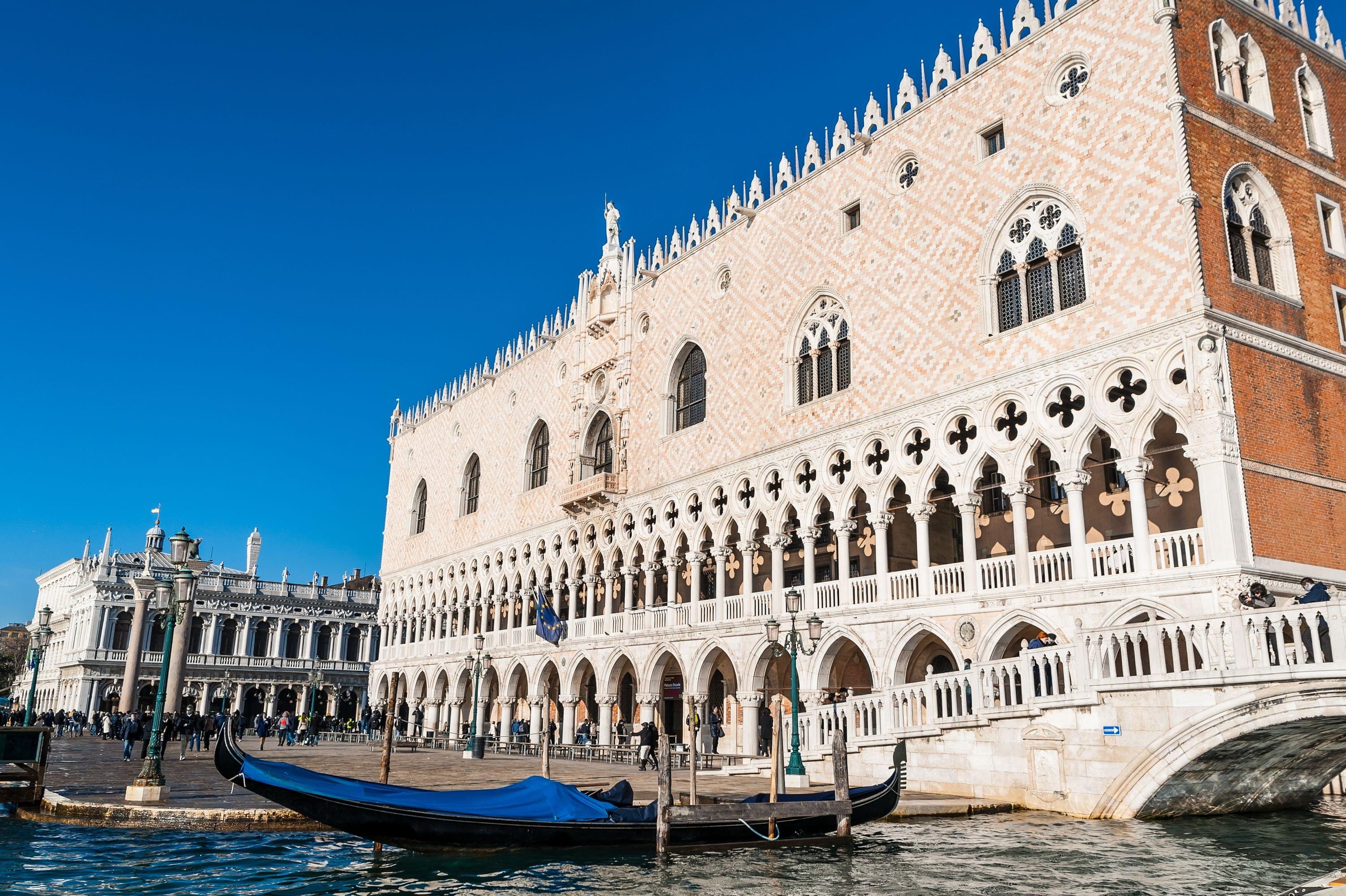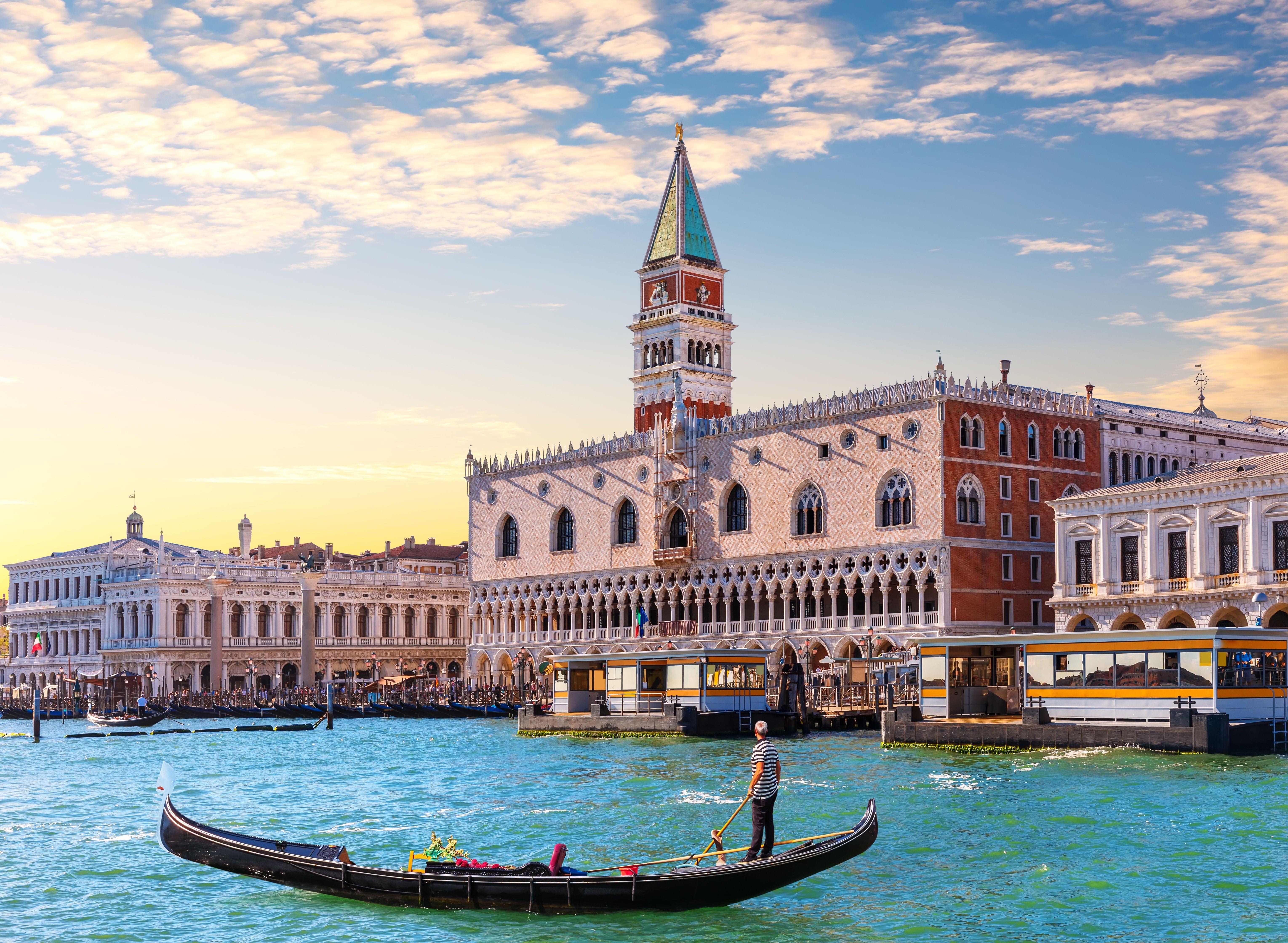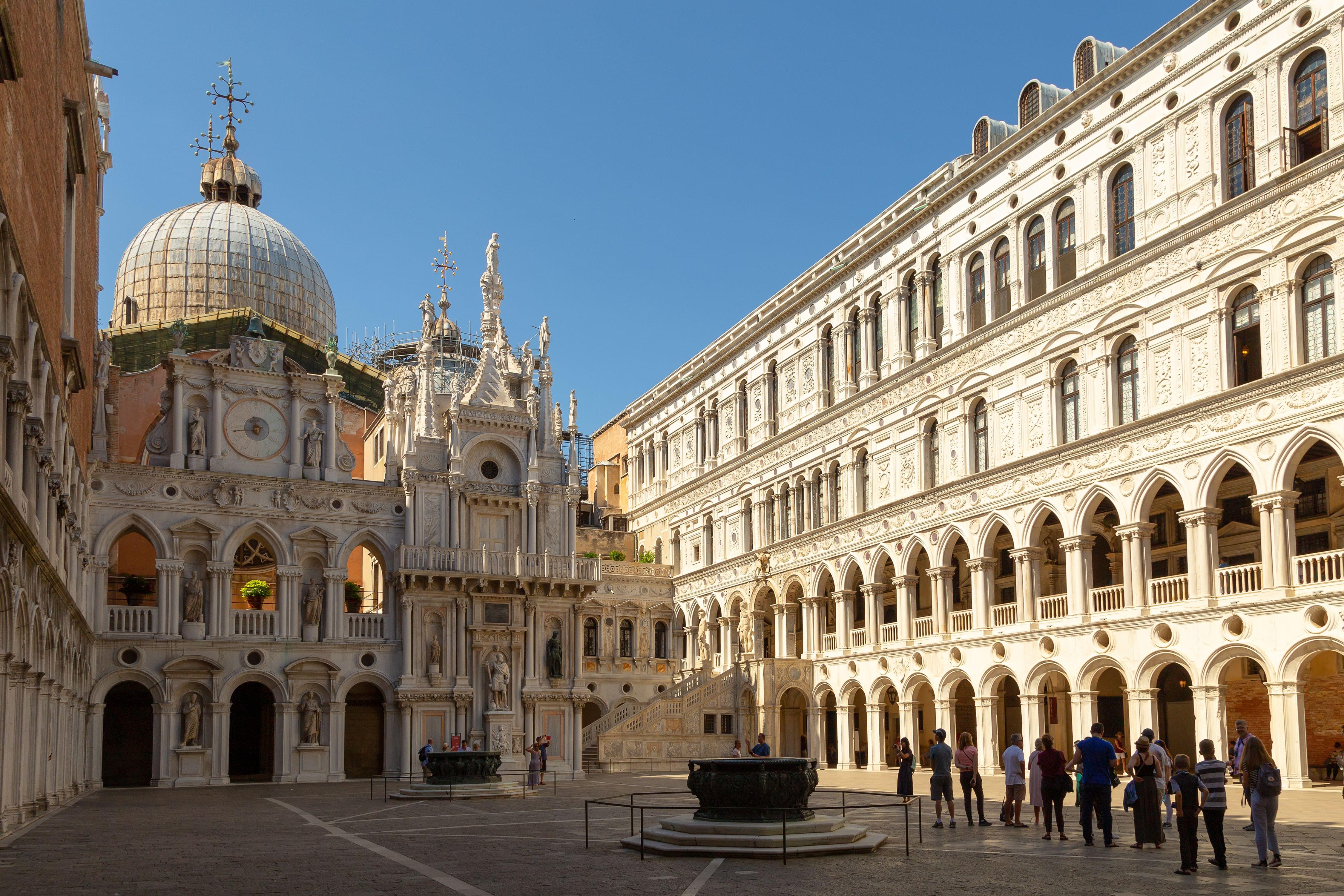Best Selling Doge's Palace Tickets
Doge's Palace Skip the Line Tickets
Visit the famous Doge's Palace in Venice, built in the 14th century, and marvel at its amazing Gothic architecture
Marvel at the beautiful artworks like sculptures, frescoed ceilings, and paintings by famous artisans while exploring wonderfully-designed rooms
Admire the magnificent interiors of the palace including the beautiful Golden Staircase built in the 15th century
Gain some insight into the history of the once-all-powerful Doges of Venice and the seat of a 1000-year republic as you stroll through this historic landmark
Book Doge's Palace tickets and admire the outstanding works of various famous artists like Tiepolo, Tintoretto & Titian
- All foreign nationals must share their passport and visa details at the time of arrival.
- ID proof is mandatory for each individual guest at the time of arrival.
- Enter the Doge's Palace anytime between 10:00 and 18:00. Last admission one hour before closing. It is recommended to go after 11am to avoid long lines.
- No large bags or backpacks allowed in the palace.
- Live guide is only available on the gondola tour.
St. Mark's Basilica and Doge's Palace Tickets
Step into the rich history of Venice with a Doge's Palace and Saint Mark's Basilica Combo, exploring two iconic landmarks in one tour
Marvel at the breathtaking architecture of Doge's Palace, once the residence of Venetian rulers, and uncover its hidden stories and grandeur
Admire the sacred beauty of Saint Mark's Basilica, decorated with stunning mosaics and beautiful artworks showcasing the brilliance of Byzantine architecture
Witness the remarkable paintings that grace the walls of Doge's Palace, portraying captivating tales and offering a glimpse into Venetian heritage
- Please do not carry any luggage or large bags.
- All participants are required to show ID on arrival.
- All international participants will have to share passport and visa details on arrival.
- Participants are not allowed to carry any sharp object, lighter, luggage bag, alcohol, knife, etc.
Doge's Palace Tickets Options
Say goodbye to long queues and dive straight into the captivating world of the Doge's Palace with our Skip-the-Line tickets. Maximize your time to focus on the mesmerizing history and architecture without the hassle of waiting.
Elevate your exploration by choosing our Combo Tickets, granting you access not only to the Doge's Palace but also to other prominent attractions in Venice. Immerse yourself in the city's cultural richness by combining your visit with landmarks such as St. Mark's Basilica. It's a curated experience that offers more value and a comprehensive exploration of Venice's treasures.
Why Choose Doge's Palace Tickets from Us?
We prioritize your convenience from the moment you decide to explore the Doge's Palace. Our user-friendly online platform streamlines the ticket booking process, allowing you to effortlessly secure your entry without the hassle of navigating through complex procedures. With just a few clicks, you can ensure a seamless experience for you and your companions.
We understand the importance of providing value for your money. By choosing us, you gain access to competitive prices for Doge's Palace tickets, ensuring that you get the most out of your budget. Our commitment to affordability doesn't compromise the quality of your experience, allowing you to enjoy this iconic Venetian landmark without breaking the bank.
Time is precious, especially when exploring a destination as captivating as Venice. Opting for our services means saving valuable time that you can allocate to fully immerse yourself in the history and beauty of the Doge's Palace. Say goodbye to long queues and delays – our efficient ticketing system ensures a swift and hassle-free entry, maximizing the time you spend exploring this architectural masterpiece.
The Story Behind Doge's Palace
Why Visit the Doge’s Palace?
To know the darker side of the palace
- As you explore areas like the council chamber, you will be able to witness the chilling torture rooms and step into the haunting Bridge of Sighs. Each room whispers secrets of political conspiracies and hidden histories. To get an in-depth glance into Venice's dramatic past get your Doge’s Palace tickets.
To know the historic dominance
- Explore Venice's heart of power. It wasn't just a grand structure but the Doge's residence, the leading magistrate of the city. Despite its grandeur, the Doge's residence showed humility and a commitment to serving the public.
To explore the Interior of the Doge’s Palace
- Beyond the huge staterooms and the gold-plated staircase, the palace is also home to artworks from Renaissance artists. The Great Council chamber, with its vast paintings, represents Venice's artistic and political legacy.
What to See at the Doge's Palace?
The Museo dell’Opera, consists of the works of the two facades and original columns in six different rooms of the museum. These carved capitals and sculptures at Doge's Palace tell a stony tale of history, legend, sacredness, profanity, astrology, and astronomy. All these capitals represent allegorical figures, historical characters, animals, plants, and faces of different races. Some of the capitals of the Museo dell’Opera even present themes of the products of the earth and astrological correspondences.
The north side of the courtyard is an intersection between the Doge’s Palace and the St. Mark’s Basilica. You will discover two well-heads in the centre of the courtyard dating back to the mid-16th century. The Courtyard consists of the Giants’ Staircase that was used for formal entrances, which represents the power by sea and by land. Loggias are the itinerary walks that take you from the Renaissance wing to the Gold Staircase, where you will find numerous offices of the State Government.
The Doge’s Apartments were always situated in the wing of the Ducal Chapel. The entire apartments were destroyed by fire and were then reconstructed in the Renaissance style. These apartments showcase different rooms, wooden engraved ceilings, and monumental marble chimneys. The rooms in these apartments were used for the private line of the Doge until the 17th century. But today, it is used for temporary exhibitions of Doge’s Palace artworks in the palace.
The Institutional Chambers at the Doge’s Palace commences in the Square Atrium. These chambers consisted of the political and judicial administrative organs that were the main cause of Europe’s jealousy for centuries. Visiting Doge’s Palace, you will cross the fundamental organs of the government, namely the Senate, the Collegio, and the Great Council.
The Bridge of Sighs in the Doge’s Palace are the corridors that were constructed to link the Doge's Palace prisons to the palace. These corridors were named after the sighs of the prisoners that passed from the courtroom to the cells where they would be served their sentence. During the 16th century, new Prisons were built that housed the chambers of the magistrates and prisons known as the Notte al Criminal. These new prisons were constructed with more light and air-filled cells with the intention to enhance the conditions of the prisoners. However, the prisons failed to fulfill the aim. Thus, each cell was bordered with overlaying larch planks.
The rooms of the Armoury in Doge’s Palace are filled with precious historical collections of ornaments, weapons, and Doge Palace’s artworks from different sources. After the fall of the Venetian Republic, the arms collections were dispersed halfway, consisting of several valuable pieces, but 2000 exhibits still remained in the rooms of the Armoury.
The remaining exhibits included renowned instances of armor suits of the 15th and 16th centuries, with crossboards, halberds, swords, and quivers. You will find monogram CX for “Council of Ten” inscribed in these exhibits. The other collections of the armory include ships’ lanterns, weapons, standards, torture implements, chastity belts, firearms, and tiny but lethal weapons.
Explore More About the Doge’s Palace
With foundations dating back to the 14th and 15th centuries, the Doge’s Palace evolved over time, reflecting the grandeur and power of the Venetian Republic. As the home of the Doge, the highest Venetian authority, it has been witness to political events and the rise and fall of empires. The presence of the legendary Bridge of Sighs adds to its historical allure. To delve deeper into the history of time, ensure you buy tickets for Doge’s Palace, Venice.
Doge’s Palace introduces you to a huge collection of artworks, each showcasing Venice's culture. Highlights include the majestic "Paradise" fresco by Tintoretto, adorning the Great Council Chamber's ceiling, and the "Four Tetrarchs" sculpture, a symbol of the Roman Empire's unity. Every artwork, from ornate sculptures to the iconic "Golden Staircase", depicts the lavishness of Venetian heritage.
Explore the treasure house of Renaissance paintings that capture Venice's opulence. Masterpieces like Veronese's ceiling paintings in the Council of Ten room, titled "The Apotheosis of Venice" and "The Triumph of Venice over the Turks", reflect the city's dominant era. Furthermore, Tintoretto’s depiction of Paradise remains a testament to artistic brilliance. Each painting not only captivates with its beauty but also narrates tales of Venice's glorious past. For an unparalleled visual feast, book your tickets to the Doge’s Palace, Venice.
Plan your Visit to the Doge's Palace
Location:
Doge's Palace, also known as the Palazzo Ducale, is located in Venice, Italy. It stands on the Grand Canal and is situated next to St. Mark's Basilica in the Piazza San Marco (St. Mark's Square).
Timings:
- From April 1st to October 31st: 8:30 AM to 7:00 PM.
- From November 1st to March 31st: 8:30 AM to 5:30 PM.
You can reach Doge's Palace by Vaporetti (Water bus):
- From Lido di Venezia: You can either take Line 1, Vallaresso or San Zaccaria stop or Line 5.2 San Zaccaria stop. Each of these lines will take you to your ideal destination.
- From Piazzale Roma: If you are traveling from Piazzale Roma, you can Line 1, Vallaresso or San Zaccaria stop, Line 2 Giardinetti stop, or Line 4.1 or 5.1 San Zaccaria stop to reach Doge’s Palace in Venice.
- From Santa Lucia Railway Station: Visitors can take Line 1 Vallaresso or San Zaccaria stop, Line 4.1 or 5.1 San Zaccaria stop, or Line 2 Giardinetti stop from Santa Lucia railway station to reach the Doge’s Palace in Venice.
The best time to visit Doge’s Palace remains between April and May and then from September to November. During these months, the weather remains pleasant and you get long hours of daylight to explore the beautiful Doge’s Palace artworks and interiors.
Moreover, the place remains less crowded at this time and the hotels are available at a cheaper rate. Hence, you can save lots of money on other adventures too. If you are planning to take a trip to Venice during Christmas, you must travel to Doge’s Palace as the glittering lights of the festival will blow your mind.
As far as the time of the day is concerned, it is advisable to visit Doge’s Palace in the early mornings to avoid long waiting lines. You must also avoid going to the palace during weekends as the place remains comparatively more crowded than on weekdays.
Services:
- Audio guide & Cloakroom.
- Baby pit shop (Dedicated room for breastfeeding, changing, and relaxing).
- Bookshop, Desk info, Lift, Museum Cafè & Toilette.
Accessibility:
- Regular visits are completely accessible to visitors.
- You can easily access toilets on the ground floor.
- Visitors cannot access the Armoury, Prisons, and Secret Itineraries.
- The unorganized school groups of over 10 people or groups that have bought educational activities as proposed by MUVE Education should utilize whisper audio equipment.
- The rent of the whisper audio equipment is EUR 1 per person, and it is required to be paid at the cash desk for a whisper.
- The charges are free for a maximum of 2 accompanying teachers and any certified handicapped accompanying person.
- An adult member of the group is required to sign a form at the time of the collection of equipment, taking responsibility for any loss or damage to the equipment.
- You must also give a valid identity document at the whisper equipment desk.
- Before getting access to the attraction, people who wear a veil are required to present their identification at the entrance of the Doge’s Palace.
- The bags and rucksacks are required to be checked at the entrances of the Doge's Palace museum.
- You are requested to keep any heavy items in the cloakroom.
FAQ
Do you need tickets for Doge’s Palace?
Yes, you need Doge's Palace tickets to be able to explore this popular landmark in Venice. This historic gem requires tickets to ensure crowd management and maintain its architectural and cultural integrity, allowing you to immerse yourself in its splendid Venetian history. Furthermore, getting your tickets to Doge’s Palace, Venice ensures that your visit here is secured and confirmed.
How do I get tickets for Doge’s Palace?
While you can get the Doge’s Palace tickets offline at ticket counters, it is best to purchase them online. Not only is it a hassle-free method, but purchasing tickets to the Doge’s Palace Venice online also allows you to choose preferred slots, especially during peak tourist seasons when it gets quite crowded.
How long does it take to see the Doge’s Palace?
Dedicating around 1 to 2 hours for Doge’s Palace is advisable. This duration allows visitors like you to deeply appreciate its exquisite artworks, unique architecture, and the intriguing stories hidden within its walls.
Where to buy tickets for Doge’s Palace?
The best avenue to purchase tickets for Doge’s Palace is via dogepalace-tickets.com. This platform is designed for quick, reliable transactions, giving you peace of mind in knowing your tickets are confirmed well in advance. Additionally, when you get it from this platform, you can also avail exclusive deals and exciting discounts, thereby making your visit even more memorable.
What are Doge’s Palace opening hours?
The Doge’s Palace opening hours are distinct based on seasons. From April 1st to October 31st, you can explore from 09:00 a.m. to 07:00 p.m., ensuring your entrance before 06:00 p.m. Whereas, between November 1st and March 31st, the timings are 09:00 a.m. to 06:00 p.m., with the last admission at 05:00 p.m.
Is the Doge’s Palace wheelchair accessible?
Yes, while the core sections of the Doge’s Palace are wheelchair-accessible, there are exceptions. Wheelchair-accessible toilets are available on the ground floor. However, areas like the secret Itineraries, Prisons, and Armoury remain inaccessible to wheelchairs.
Why is Doge Palace famous?
Doge Palace is a famous building in Venice that is regarded as the official ground of the ruler of Venice, Doge. It is also known as the seat of power for the Venetian Republic. The palace shows the premium authority of the former Republic. Doge Palace is famous for its Venetian architecture and the fascinating stories of the Venetian Republic.
What are the places to visit near Doge’s Palace?
There are innumerable attractions near Doge’s Palace that you must include in your travel itinerary are St. Mark’s Basilica, Piazza San Marco, Basilica Di San Marco, Grand Canal, and Rialto Bridge. Besides this, you can also visit the different museums, restaurants, and shops clustered around the attraction.



